Summary | Excerpt | Reading Guide | Discuss | Reviews | Beyond the Book | Read-Alikes | Genres & Themes | Author Bio
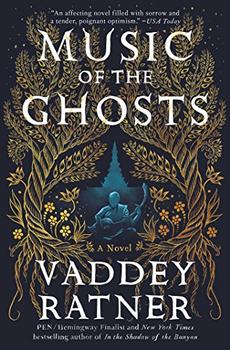
This article relates to Music of the Ghosts
Traditional Cambodian music plays a key role in Music of the Ghosts. Hearing it triggers memories for both of the story's main characters, and three hand-made instruments—a single-stringed lute, an oboe, and a drum—set the plot in motion.
Music and Buddhism have a strong connection; music is sometimes seen as a ceremonial offering to the Buddha. An estimated 95% of Cambodians are Buddhist today, and the roots of Buddhism date back to the 5th century. Over that long history, Buddhist songs have been adapted for use in ceremonies such as weddings and funerals, playing an integral role in common cultural practices.
The lyrics of traditional musical pieces often have a moral or religious theme. The smoat (also smaut or smot) is an ancient and specific form of sung poetry that is sometimes accompanied by a solo instrument. A Buddhist performance art that falls between chanting and singing, it is described as haunting, powerful and didactic, but also as sweet, melodious, and musical.
Though the history of music in Cambodia is long and rich, it was left broken during the Khmer Rouge regime, from 1975 to 1979. During that period, many artists and musicians were executed and many others died of illness or starvation. An effort to re-establish traditional arts in the wake of the war's devastation has been underway in Cambodia for some time. Advocacy groups such as Cambodian Living Arts are actively working to revive the country's traditional music by supporting performers and teaching young people. Several ensembles of landmine victims also now perform in the countryside, selling CDs to support their families.
The traditional musical instruments of Cambodia, often crafted by hand, generally fall into woodwind, strings, or percussion categories. They are difficult to make and to play. Some examples include:
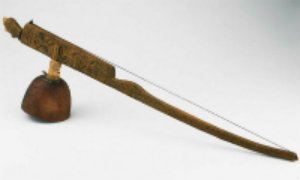 Lute (kse diev)— an ancient one-stringed instrument, called "sadiev" in Music of the Ghosts. This instrument has a long neck and single string and sounds like a guitar. It is plucked with a false fingernail on the right ring finger and is known as "the instrument of the heart" because the open gourd is held close to the musician's heart.
Lute (kse diev)— an ancient one-stringed instrument, called "sadiev" in Music of the Ghosts. This instrument has a long neck and single string and sounds like a guitar. It is plucked with a false fingernail on the right ring finger and is known as "the instrument of the heart" because the open gourd is held close to the musician's heart.
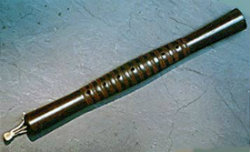 Oboe (sralai)—a woodwind instrument that dates back to before the 15th century. The sralai is used in traditional ensembles to accompany various cultural performances. The body is made of hard wood in a shape that bulges in the center and flares outward at both ends.
Oboe (sralai)—a woodwind instrument that dates back to before the 15th century. The sralai is used in traditional ensembles to accompany various cultural performances. The body is made of hard wood in a shape that bulges in the center and flares outward at both ends.
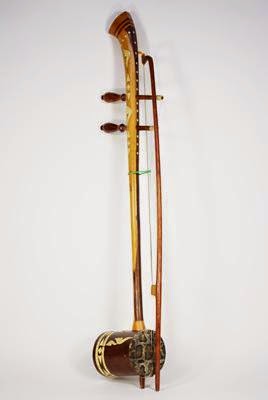 Fiddle (tro)—a category of bowed, stringed instruments. The resonator, which varies in size, also varies in material. Higher-pitched tro have resonators made of bamboo or wood while lower-pitched tro have resonators made of coconut shell, often in the shape of an elephant's head.
Fiddle (tro)—a category of bowed, stringed instruments. The resonator, which varies in size, also varies in material. Higher-pitched tro have resonators made of bamboo or wood while lower-pitched tro have resonators made of coconut shell, often in the shape of an elephant's head.
Flute (khloy)—an ancient flute, often made of bamboo. This instrument is one of the oldest in the world. In Cambodia, the khloy is held vertically and sound is produced by blowing into a duct at its tip. It has 6 or 7 finger holes and sometimes a thumbhole. It is played in ensembles and as a solo instrument.
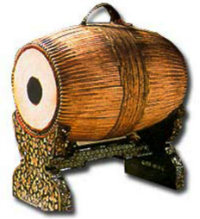 Drum (sampho)—a small, barrel-shaped drum. The body begins as a solid piece of wood that is hollowed out and covered with calfskin and then tightened with gut or rattan strips. It is held horizontally and has two heads with one slightly larger than the other. It is played using the palms of the hands.
Drum (sampho)—a small, barrel-shaped drum. The body begins as a solid piece of wood that is hollowed out and covered with calfskin and then tightened with gut or rattan strips. It is held horizontally and has two heads with one slightly larger than the other. It is played using the palms of the hands.
To listen to a performance of the kse diev from a master, click on the video below:
Picture of kse diev from Tropenmuseum, Amsterdam
Picture of sralai from University of Maryland, Baltimore County
Picture of troh from http://trokhmer.blogspot.com/
Filed under Music and the Arts
![]() This "beyond the book article" relates to Music of the Ghosts. It originally ran in April 2017 and has been updated for the
April 2018 paperback edition.
Go to magazine.
This "beyond the book article" relates to Music of the Ghosts. It originally ran in April 2017 and has been updated for the
April 2018 paperback edition.
Go to magazine.
Your guide toexceptional books
BookBrowse seeks out and recommends the best in contemporary fiction and nonfiction—books that not only engage and entertain but also deepen our understanding of ourselves and the world around us.